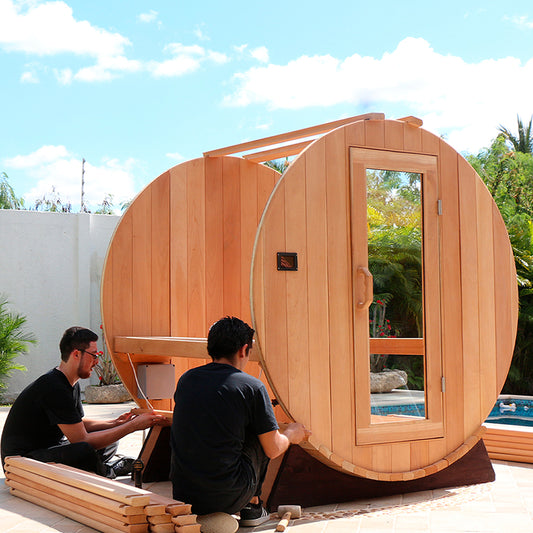What is the difference between a traditional sauna and an infrared sauna?
A traditional sauna is a wooden room or structure that uses heated stones and water to create a hot and humid atmosphere that provides several health benefits. This room is often large enough to accommodate many people but ultimately can be built to be any size.
Types of Saunas

Whether you go to a spa, the gym, or are one proud owner of a home sauna; there are different types of dry heat saunas.
HOME SAUNAS
Home Saunas are becoming a trend these days very much. Their design and technological advancement continue to improve, so installing one in your home today with simple DIY home sauna kits or portable saunas is much simpler.
INDOOR SAUNAS


Pre-Cut Sauna Kits are installed to the studs of an existing wall/room.
You choose the size and style; the sauna kit includes everything required to complete the project: wood, door, heater, vents, lighting, wiring, and hardware.
Modular Saunas (Portable Sauna)
They allow easy mobility within a larger space and require little (or no) deconstruction when moving to your home's different room or area.
OUTDOOR SAUNAS


Some examples of outdoor saunas include the traditional barrel sauna model. The barrel sauna concept does not only enhance your backyard but your health. These easy to assemble, practical and beautiful sauna rooms provide a unique look and outdoor living experience.
How Saunas Produce Heat
There are three main types of Sauna Heaters:
- Electric Sauna Heater
- Gas Sauna Heater.
- Wood-Burning Sauna Stove
Infrared Sauna's Heat vs Traditional Sauna Heat

Infrared heat is light on a spectrum that our eyes can't see. Yet, not being able to see it doesn't mean we can't experience it. When the infrared light reaches our body, we perceive it as heat. For example, if you get out into direct sunlight then step into the shade, you'll notice that you feel hotter in the direct sunshine. That's caused by the infrared light emitted by the sun.
Infrared saunas had an intriguing beginning. The first ones were made with the heaters used in hospitals to keep newborns warm. Some early models also used different kinds of infrared lamps, such as food lamps. Later development has led to specialized heater types used only in infrared saunas. These new heaters have very low EMF (electromagnetic field) levels and better heat dispersal.
Infrared saunas share important similarities with traditional saunas, especially when it comes to health benefits. But the way they distribute heat is entirely different. Let's explain how.
Infrared heaters give "direct heat" to your body while the traditional ones heat the air in the sauna. What this means in practice is that infrared saunas are faster to heat up. In an infrared sauna, you'll start feeling the heat immediately when you turn the sauna on. For an optimal experience, we recommend waiting 15-20 minutes for your sauna to heat up.
In traditional saunas, the heater needs a lot of time to reach an ideal temperature, especially if it has a large number of stones. We're talking 30-60 minutes or a little more depending on the weather outside. With an infrared sauna, you get faster heat with less energy use and a cheaper electric bill.
Another difference lies in the way you feel the heat throughout your body. In an infrared sauna, you'll feel the heat where the infrared light hits your body (the "direct heat"). In the traditional sauna, you feel the heat more evenly throughout your body - since it comes from the air that gets heated up.
SO WHICH IS THE RIGHT SAUNA FOR ME?

People have been using saunas for thousands of years. This was long before we had electricity or knew that something named a photon ever existed. Largely it's agreed that heat exposure has proven to be one of the most powerful tools in maintaining personal health and improving strength training and endurance. But as for which is better, for the most part, there isn't any reputable data to support claims that one type of sauna is better than the other. There is data that says hotter is typically better.
Of course, both types of sauna have various benefits including:
1. Toxin removal through sweating
You won't sweat as much when using an infrared sauna, however many manufacturers report sweat induced from an infrared sauna contains more toxins.
2. Improved skin by flushing out impurities and dead skin cells
This can reduce break outs and certain skin conditions.
3. Strengthens the immune system
Heating the body can help you avoid the common cold and other ailments.
4. Assisting in weight loss
Heating the body can help you avoid the common cold and other ailments.
5. Improved cardiovascular health
Increasing the heart rate and blood circulation without affecting blood pressure is a great, low-risk way to improve cardiovascular health.
Conclusions
The type of sauna you use will often come down to your personal preference. In saunas.com, you can find your very own personal sauna, whether you prefer an outdoor sauna or indoor sauna.
Saunas.com is the most complete sauna shop available online.




